Agriculture in Greece
Agriculture in Greece is based on small, family-owned dispersed units, while the extent of cooperative organization stays at low comparative levels, against all efforts that have been taken in the last 30 years, mainly under European Union supervision. Greek agriculture employs 528,000 farmers, 12% of the total labor force. It only produces 3.6% of the national GDP (about $16 billion annually). Many of the country's immigrants are employed in the agricultural sector of the economy, as well as construction and public works.
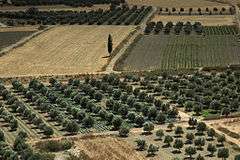
| Economy of Greece |
|---|
 |
| Overview |
|
| History |
|
| Related |
|
Greece produces a wide variety of crops and livestock products. Fisheries are also playing an important role while forestry plays a secondary role.
Current
Currently, Greek agriculture is heavily subsidized by the Common Agricultural Policy (CAP), with controversial results. Certain deductions of subsidies are planned within the next decade.[1]
Modern history
19th century

In the 19th century, Greek agriculture was very basic. Implements found in western Europe had not yet appeared. The following description was reported by William Henry Moffett, American Consul in Athens and was published in the American periodical Garden and Forest (Volume 2, Issue 95, 18 December 1889, p. 612: published by Garden and Forest Publishing Co., Tribune Building, New York, N.Y.):
- William H. Moffett, United States Consul at Athens, reports the impossibility of making any official statement as to the agriculture of Greece, because "agriculture is here in the most undeveloped condition. Even in the immediate neighborhood of Athens it is common to find the wooden plow and the rude mattock which were in use 2,000 years ago. Fields are plowed up or scratched over, and crops replanted season after season, until the exhausted soil will bear no more. Fertilizers are not used to any appreciable extent, and the farm implements are of the very rudest description. Irrigation is in use in some districts, and, as far as I can ascertain, the methods in use can be readily learned by a study of the practices of the ancient Egyptians. Greece has olives and grapes in abundance, and of quality not excelled; but Greek olive oil and Greek wine will not bear transportation."
20th century
Greek agricultural production was vastly expanded in the 20th century, as per the information given elsewhere on this page. In particular grain production (wheat, barley, etc.) has been significantly increased using more modern farming methods.
There were over 8,000 farms all over Greece in 1998, with 9,730 hectares of land used for the growing of organic farming.[2]
The main varieties of domestic wheat produced in Greece during 2002 were FLAVIO, VAVAROS and MEXA.[3]
Notable products
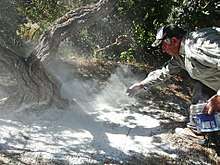
Notable products include:
- Avgotaracho of Messolonghi
- Zante currant
- Greek wine
- Fava Santorinis
- Santorini tomato
- Krokos Kozanis (saffron)
- Florina pepper
- Mastic (plant resin) of Chios
- Tobacco production (region of Macedonia)
Olive cultivars/varieties
| Name | Image | Areas | Description |
|---|---|---|---|
| Adramitini | |||
| Amfissas | Alternate name is Amphissis | ||
| Amigdalolia | |||
| Athinolia | Low viscosity | ||
| Chemlali | |||
| Conservolia | |||
| Daphnoelia | |||
| Frantoio | |||
| Gordal | |||
| Chalkidikis | Chalkidiki | Green olives. Also known as Chondrolia and called "donkey olives". | |
| Hondroelia | |||
| Karidolia | |||
| Kalamatas | Messinia in Southern Peloponnese. | Usually a brown or black table olive. When picked early, known as "pink" olives (reddish color). They have PDO status for the Kalamata region. Known as "Kalamon olives" outside this region. | |
| Koroneiki | Messinia, Peloponnese, and Zakynthos. | Cretan olives, referred also as elitses | |
| Kothreiki | |||
| Lianolia | |||
| Mastoidís | |||
| Megaritiki | |||
| Mirtolia | Mainly Laconia | Also Smertolia/Mourtolia | |
| Nafpliou | Valley of Argos in the Eastern Peloponnese peninsula. | Usually a table olive | |
| Patrinia | Primarily in Aigialeia. | High oil concentration of around 25% | |
| Picholine | Also Marocaine | ||
| Throubes or from Thassos | Island of Thassos | Naturally wrinkled when ripe and allowed to fall into nets. The only olives that can be eaten straight off the tree. | |
| Throumbolia | |||
| Tsounati (Ladolia) | |||
| Valanolia | |||
Gallery
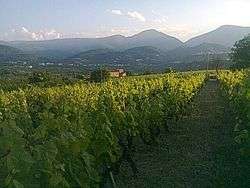 Vineyard in Naoussa, central Macedonia
Vineyard in Naoussa, central Macedonia Assyrtiko grapes
Assyrtiko grapes Sun-drying of Zante currant on Zakynthos
Sun-drying of Zante currant on Zakynthos Fish farming, Argolic gulf
Fish farming, Argolic gulf.jpg) Cattle in Prespes
Cattle in Prespes Buffalos breeding, Lake Kerkini
Buffalos breeding, Lake Kerkini.jpg) Fava Santorinis
Fava Santorinis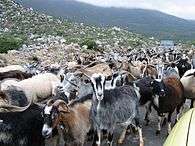 A herd of goats on the Greek highlands
A herd of goats on the Greek highlands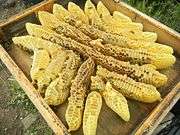 Beekeeping in Lesbos
Beekeeping in Lesbos
References
- The Greek Observer:Vangelis Apostolou briefs Greek MEPs on EU’s post-2020 Common Agricultural Policy (JULY 3, 2018)- Retrieved 2018-07-02
- R Bitsaki - Mediterranean Agronomic Institute of Chania Retrieved 2012-06-09
- S Sekliziotis (USDA): 2002-11-09 - Foreign Agriculture Service Retrieved 2012-06-09
- UCDavis.edu- Retrieved 2018-07-02
- The olive centre- Retrieved 2018-07-02
- MDPI.com Archived 2018-07-02 at the Wayback Machine- Retrieved 2018-07-02
- The Spruce eats- Retrieved 2018-07-02